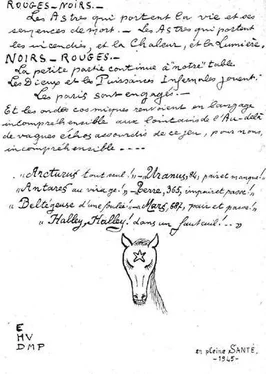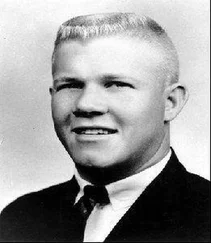As Madame Guschinow continued relating what she knew about the enterprise, Massu learned that her husband had been referred to one of Petiot’s colleagues, a specialist in tropical diseases who would make some “necessary injections,” presumably vaccinations. Guschinow was asked to pack a special suntan lotion, two blankets, and selected valuables in no more than two suitcases. That evening, Joachim and Renée Guschinow dined together, walked around the Arc de Triomphe area, and then kissed good-bye, never to see each other again.
In March 1942, two months after her husband’s departure, Renée was worried that she had not heard from him. She visited the doctor, who was said to be the only acceptable way to contact a client abroad. Petiot assured her that her husband was doing well. After traveling through Marseille and Casablanca, he had reached Buenos Aires. Petiot showed her a postcard that he said he had received from Guschinow: “I have arrived. I got sick during the crossing but I am completely healed. You can come.” That was all it said, or at least that was what Petiot claimed it said. The letter had been written in code. There was no obvious date, stamp, addressee, or signature. It seemed to be written in Renée’s husband’s handwriting.
Two other postcards and letters purportedly from Guschinow appeared that spring, written on stationery bearing the name of the “Alvear Palace Hotel, Buenos Aires,” where Petiot claimed that Renée’s husband was living. In these communications, Guschinow never elaborated other than to say that, after nearly losing his mind at the initial departure and breaking down in tears, his voyage had been comfortable and he had arrived safely. His business was thriving, and above all, he wanted his wife to join him.
Once, on her insistence, Petiot allowed Renée Guschinow to retain the card from her husband, on the condition that she later tear it up. She had complied, she told Massu. In the last message, Guschinow demanded that his wife immediately depart, threatening to cut off ties unless she consented. Petiot seconded the urgency of the request, advising her to “sell all [her] belongings and carry as much money as possible.”
MARCEL Petiot had purchased the property on rue Le Sueur from the Princess Marie Colloredo-Mansfeld in May of 1941 for 495,000 francs. He paid 373,000 down, covering the remainder with annual payments of 17,500. The building was put in the name of his son, who became the ninth owner since its construction in 1834. On August 11, 1941, Petiot took possession of the town house, and within six weeks, he began making renovations.
The construction company, Laborderie et Minaud, had made a number of improvements to the property. In addition to pouring a concrete foundation in the garage, the masons had built a high outer wall in gypsum around the courtyard and constructed an inner wall in one of the buildings, which created the triangular room. They then surrounded this new space with a wall consisting of twenty-two centimeters (8.6 inches) of solid brick. A viewer was installed, a double door was inserted, and eight iron hooks were added. In the kitchen, they had also installed a concrete sink and, he claimed, plugged some holes in the basement that gave access to the sewer. The renovation work was completed in October 1941—two months before the disappearance of the first known victim, Joachim Guschinow.
Jean Minaud, one of the owners of the firm, said that he had never visited the site or inspected the work. It was a small project compared to his company’s usual ventures. He had delegated everything to two brothers, Louis and Gaston Dethève. When Massu asked to speak with them, Minaud told him that Louis had died two years before in an air raid. Gaston, however, was available, and on March 23, 1944, he accompanied the commissaire to rue Le Sueur, where he would point out the work in detail. He also removed the Lumvisor lens from the wall for examination.
As Dethève explained, Petiot had told them that he planned to open a clinic and mental institution after the war. The newly constructed triangular room would house an “electric transformer.” Petiot wanted the walls reinforced to drown out the sounds, so as not to disturb the neighbors and also to protect against the dangers of radiation. “With electrotherapy,” he had allegedly told the Dethève brothers, “you cannot be too careful.” Petiot had also explained the insertion of the viewing lens into the wall as a device to monitor the progress of his machine. The courtyard addition, which was built on top of a wall already several stories high, would protect his patients from the prying eyes of his neighbors, not to mention shield them from the peach pits that he claimed children liked to throw into his yard. As for the hooks in the triangular room, Dr. Petiot had not explained their purpose.
WITH news of the “murder factory” on rue Le Sueur splashed on the front pages of all the major Parisian papers, a number of people approached police headquarters with stories about the suspect. One of the more useful tips came from Roland Albert Porchon, a thirty-two-year-old former deliverer of wine who had made a small fortune during the years of the Occupation. He owned, among other things, a trucking company near la porte de Sainte-Cloud and a restaurant on rue du Faubourg Poissonière, which had been “Aryanized.” A large man with short dark hair and a thick neck that the French then described as Germanic, Porchon had many friends on the police force and in the criminal underworld.
Like Gouedo, Porchon claimed knowledge of the clandestine escape agency. In March 1943, Porchon had suggested it to a friend, René Marie, and his wife, Marcelle. After the usual round of background checks and interviews, the couple had been accepted by the organization. The cost was to be 45,000 francs, the fee clearly varying depending on many factors, not least being the desperation of the potential client to leave and his or her ability to pay. Porchon, who operated a secondhand furniture business on the side, had offered to buy the couple’s furniture for a lump sum of 220,000 francs. The couple, in the end, had not left with the agency.
But there was more to Porchon’s testimony. After the news on rue Le Sueur first broke, Porchon had panicked. Realizing that he had sent over a couple to the doctor and fearing that police might find their names, as well as his own, at rue Le Sueur, Porchon had tried to cover up the incident. He confessed to Massu that he had gone to the Maries, and told them, in no uncertain terms, to avoid speaking with the police. And if the police came to them, they should deny everything. Porchon, busy with his own concerns, did not need any additional hassles from the authorities.
In the course of the conversation, Porchon also mentioned a name that Massu and his inspectors kept encountering: René Nézondet. He was, they already knew, a friend of Marcel Petiot, and he had also been arrested when the Gestapo arrived at the physician’s home. They were in prison together until Nézondet’s release in June 1943. After twenty years of friendship dating back to their bachelor days in Villeneuve-sur-Yonne, Nézondet had served, in Porchon’s words, as Petiot’s “right arm.”
Nézondet had approached Porchon once with a proposal from Dr. Petiot to sell a large stock of alcohol. Porchon, tempted, picked up the phone and called a friend in a purchasing agency that sold goods in bulk to the German Occupation authorities. He was not interested. Nézondet came with many other proposals, which Porchon said he had not taken seriously.
On one such occasion in 1943, Nézondet had come to him with an idea of launching a new, German-sanctioned radio station that would operate in Paris. While they discussed the proposition, Nézondet related some gossip about Dr. Marcel Petiot, calling him “the King of the Gangsters.” Then, Nézondet added mysteriously, “I would never have believed he could ever commit murder!”
Читать дальше












